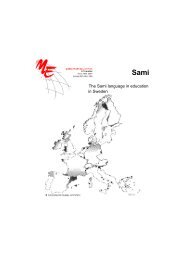Multilingual Early Language Transmission (MELT) - Mercator ...
Multilingual Early Language Transmission (MELT) - Mercator ...
Multilingual Early Language Transmission (MELT) - Mercator ...
You also want an ePaper? Increase the reach of your titles
YUMPU automatically turns print PDFs into web optimized ePapers that Google loves.
(d) The preparation of the child for responsible life in a free society, in the spirit of<br />
understanding, peace, tolerance, equality of sexes, and friendship among all peoples, ethnic,<br />
national and religious groups and persons of indigenous origin; “<br />
These two points lay the foundation for two of the thematic foci of the program namely<br />
multilingualism as well as identity and diversity. In addition, the program was developed in<br />
accordance with various ECEC guidelines. There are legal, national and local documents and<br />
policies regulating ECEC. The Ministry of Social Affairs and Health (2002) points out in its<br />
policy on ECEC that there are specific rights mentioned in the Constitution’s regulations<br />
about the basic freedoms and rights which are especially relevant for ECEC. These include<br />
equality, sanctity of human dignity, securing personal freedom and personal rights, freedom<br />
of religion as well as language and cultural rights. Furthermore, children should be treated as<br />
equals and be heard in things concerning them.<br />
The national curriculum for pre-school (education for 6-year old children) emphasizes that all<br />
children should be given the same opportunities to learn and develop. A socially just<br />
approach is emphasized also by trying to provide, for example, special education services at<br />
an early stage. The national curriculum states that children’s cultural and linguistic identity<br />
should be strengthened and given an opportunity to develop. Children should also become<br />
familiar with different art forms which support the third theme -esthetic education- in our<br />
program. It also suggests that children get to know other cultures than the local and national<br />
as much as possible.(Grunderna för förskoleundervisningens läroplan 2000,<br />
http://www02.oph.fi/svenska/ops/forskola/esiopsve.pdf) .<br />
According to the national curriculum guidelines on early childhood education and care in<br />
Finland (Stakes, 2004, p.15) a child should be “treated fairly regardless of gender or social,<br />
cultural and ethnic background”. Many other things that are highly related to our program<br />
are emphasized, for example, the importance of language, play, artistic experiences and selfexpression.<br />
The Advisory Board for <strong>Early</strong> Childhood Education and Care (2008) points out<br />
about future developments that a high quality program should diminish differences among<br />
children from different living conditions and social class backgrounds. <strong>Early</strong> childhood<br />
programs should give children equal opportunities to develop and grow in accordance with<br />
their abilities.<br />
The structure of the program<br />
The early childhood and preschool teacher education program is a three-year Bachelor’s<br />
degree program. <strong>Early</strong> childhood education and pre-school teachers have had a university<br />
based Bachelor’s degree since 1995. All teacher education is university based in Finland and<br />
early childhood and preschool teacher education is the only one that is only a Bachelor’s<br />
degree. All the other kinds of teacher certificates require a Master’s degree. The university<br />
based early childhood education teacher education also gives a preschool (6-year olds)<br />
teacher certification. There are also early childhood teacher education programs at the<br />
polytechnic level which qualify for early childhood education for 1-5 year olds but do not<br />
include a pre-school certification. The pre-school certification means an additional 60 points<br />
in teaching methods for more subject related courses. Our university based program consists<br />
114



